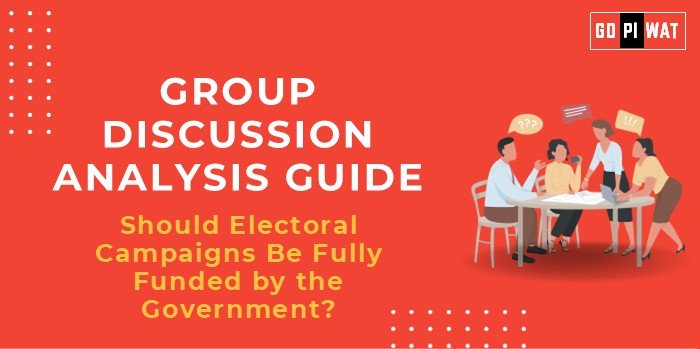📋 Group Discussion Analysis Guide
Should Electoral Campaigns Be Fully Funded by the Government?
🌟 Introduction to the Topic
Electoral campaigns are crucial for democratic engagement, enabling candidates to present their vision and policies to the public. However, concerns about escalating campaign costs and the influence of private funding have sparked a debate on whether the government should fully fund these campaigns. Countries like Germany and Canada have adopted partial public funding models, offering useful lessons.
📊 Quick Facts and Key Statistics
- Global Spending on Elections (2020): $14 billion (USA alone) – Reflects the scale and potential for undue influence in elections.
- India’s General Elections 2019: ₹60,000 crore (Centre for Media Studies) – One of the most expensive globally.
- Corruption Perception Index (2023): India ranked 85th – Highlights concerns over private funding transparency.
- Public Funding in Europe: Over 70% of EU nations provide some form of public campaign financing – Indicates international precedence.
👥 Stakeholders and Their Roles
- Government: Regulator and potential funding provider ensuring fair play.
- Political Parties and Candidates: Beneficiaries responsible for using funds ethically.
- Citizens: The electorate, who indirectly finance these campaigns through taxes.
- Election Commission: Oversees fund allocation and monitors compliance.
- Private Entities: Current major funders, whose influence might reduce under full public funding.
🏆 Achievements and Challenges
🎯 Achievements
- Transparency Improvement: Public funding can reduce reliance on opaque private donations.
- Level Playing Field: Equal funding limits favor new and smaller parties.
- Global Examples: Germany’s matching fund system balances public and private contributions.
⚠️ Challenges
- High Costs: Full public funding in a populous country like India may strain budgets.
- Accountability Concerns: Ensuring ethical usage of taxpayer money remains complex.
- Global Comparisons: USA’s voluntary presidential public funding program has seen declining participation due to spending limits.
🗣️ Structured Arguments for Discussion
👍 Supporting Stance
“Government-funded campaigns ensure that elections are decided on merit rather than financial power.”
👎 Opposing Stance
“Taxpayer money should not finance campaigns; other pressing social needs take precedence.”
⚖️ Balanced Perspective
“While public funding promotes fairness, it must be supplemented with strict oversight and private contribution caps.”
🚀 Effective Discussion Approaches
- Opening Approaches:
- Data-Driven Start: “The 2019 Indian general elections cost ₹60,000 crore, raising questions about affordability and fairness in campaigns.”
- Global Comparison: “Germany’s electoral funding model showcases how public funds can level the playing field.”
- Counter-Argument Handling:
- Challenge: “Public funding won’t eliminate corruption.”
- Rebuttal: “With robust mechanisms like expenditure audits, misuse can be minimized.”
🔍 Strategic Analysis of Strengths and Weaknesses
- Strengths: Promotes equity among candidates; reduces private sector influence on policy.
- Weaknesses: High fiscal burden; potential misuse of funds.
- Opportunities: Enhance electoral transparency; strengthen voter trust in democratic processes.
- Threats: Resistance from entrenched political interests; inadequate oversight mechanisms.
📚 Connecting with B-School Applications
- Real-World Applications: Projects on public finance management or campaign strategy development.
- Sample Interview Questions:
- “How can full public funding of campaigns impact governance?”
- “What checks and balances would ensure effective utilization of campaign funds?”
- Insights for B-School Students:
- Analyzing public funding models from a policy perspective.
- Exploring financial sustainability in governance projects.


